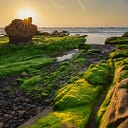The uncommon mantle-derived ultramafic volcanic rock “Komatiite”
Komatiite is a rare mantle-derived volcanic rock of ultramafic composition. It is distinguished from the more common basaltic magma by a higher content of MgO and low contents of other elements. Komatiite is the signature rock type of Archean greenstone belts and is found across the entire age of Archean crust, and is virtually absent in younger regions.
This restriction in age is due to the cooling of the mantle, which may have been 100–250 °C hotter during the Archaean. The early Earth had much higher heat production, due to the residual heat from planetary accretion, as well as the greater abundance of radioactive isotopes. Lower temperature mantle melts such as basalt and picrite have essentially replaced komatiites as eruptive lava on the Earth’s surface.
Komatiites have low silica, potassium, and aluminum, and high to extremely high magnesium content. Komatiite was discovered by Richard and Morris Viljoen in 1969 and named for its type locality along the Komati River in South Africa. it displays spinifex texture composed of large dendritic plates of olivine and pyroxene.
Apart from the Archaean shield areas, The youngest komatiites are found in the island of Gorgona on the Caribbean oceanic plateau off the Pacific coast of Colombia. A rare example of Proterozoic komatiite is found in the Winnipegosis komatiite belt in Manitoba, Canada.
Origin of spinifex texture
Spinifex texture is commonly found in the interior of komatiite flows, well below the upper chilled crust. In the thickest units, large dendritic crystals appear to have crystallized at depths 10 or more meters below the surface of the flow. The name Spinifex is derived from the Spiky grass in Australia.
Variety of ultramafic lavas that crystallize from high-temperature magmas with 18% to 32% MgO, They often form pillows and have chilled flow-tops, and usually display well-developed spinifex textures with intergrown skeletal and bladed olivine and pyroxene crystals set in abundant glass.
Under such circumstances, the loss of heat from the interior of the flow is controlled by conduction through the upper solidified crust. In a typical 2-m-thick komatiite flow, the cooling rate during crystallization of the lower part of the spinifex layer is only 1 to 3°C per hour.
Erupted komatiite contains a small proportion of olivine phenocrysts that grew either during ascent to the surface or during flowage on the surface. During cooling, some of these phenocrysts become trapped in the crust that forms right at the top of the flow, others settle towards the base of the flow and become part of the lower cumulate layer. Olivine then nucleates in the layer of crystal-free liquid just beneath the crust. The crystals that grow from these nuclei have highly skeletal morphologies, due to the high cooling rate in the crust of the flow, and they are randomly oriented.
Geological environment
Komatiite lavas were almost certainly erupted in subaerial and shallow marine environments as well, but they have been eroded. Although some vesicular komatiite lavas exist, Pyroclastic komatiite successions have been rarely recognized.
also read- Amazing Inter-trappean beds of Rajmahal Formation, upper Gondwana sequence-Geotourism
These include primary and variably reworked deposits of shards, vesicular pyroclasts, and accretionary lapilli. Komatiite units can be tens or even hundreds of meters thick and can be traced continuously for up to 20 km, indicating that komatiite eruptions were major events during the Precambrian.
In typical komatiite lava, the textural profile of the lava from top to bottom-
Zone A: characterized by spinifex-textured rock.
Zone B: containing a high proportion of equant olivine crystals resembling various peridotite to dunite cumulates.
Mineralogy and petrology of Komatiite
Komatiites represent primitive mantle melts and require a high degree of partial melting of the mantle (up to 50 %). The formation of komatiites has generally been attributed to mantle plume upwelling and related volcanism in a variety of geodynamic settings mainly during the Archean and early Proterozoic.
The predominance of komatiites in the Archean, their decreasing occurrence in the Proterozoic, and extreme rarity in the Phanerozoic have been interpreted to reflect secular cooling of the mantle.
Because the MgO contents of anhydrous magmas are proportionally related to their melting temperature (high MgO results from high melting temperatures), komatiite melts require significantly higher temperatures than the 1250–1350°C responsible for recent MORB. Traditionally, most petrologists have accepted that during the Archean and Paleoproterozoic, komatiite melting temperatures ranged from 1600–1900°C.
Komatiites and related rocks have been affected to variable degrees by metamorphism, hydrothermal and seafloor alteration, and deformation, that change the original textures and primary mineralogy.
Low-grade metamorphism of komatiites produced mineral assemblages dominated by serpentine, chlorite, talc, tremolite, magnesite-dolomite, and magnetite. At higher metamorphic grades, metamorphosed komatiites contain anthophyllite, enstatite, olivine, and diopside.
The primary mineralogy of komatiites is simply phenocrysts of olivine and spinel/chromite (± pyroxene) are enclosed in a groundmass composed of glass, calcic clinopyroxene, and minor orthopyroxene.
Occurrence
In India Komatiite is found Dharwar craton, Associated with metamorphosed pyroxenite, Norite Gabbro, anorthosite, and Chromite schist. Komatitie is Also found in Singhbhum Craton. Komatiites are economically important because they host locally significant magmatic Ni-sulfide (Ni-Cu-PGE) mineralization.
